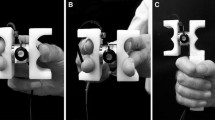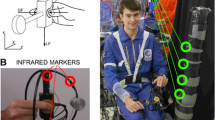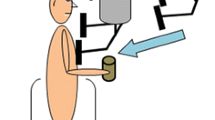Abstract
We investigated motor control perspectives of coordinating maintenance of posture and application of grip force when holding an object and being perturbed. Ten subjects stood on the force platform holding an instrumented object in their dominant hand and were exposed to an external perturbation applied to their shoulders. Task demands were manipulated by positioning a slippery cap on top of the instrumented object. Grip force applied to the object, the object acceleration and the center of pressure (COP) were recorded and analyzed during the time intervals typical for the anticipatory (APA) and compensatory (CPA) components of postural control. Onsets of grip force were seen before the onsets of the COP displacement and initiation of movements of the handheld object during the APA phase of postural control, while the onsets of maximum grip force preceded the maximum COP displacement during the CPA phase. When the task demands increased by holding a handheld object with the slippery cap, subjects tended to generate grip force earlier and of a smaller magnitude; also, the COP displacement in the APA phase was smaller as compared to holding a handheld object only. The outcome provides a foundation for future studies of maintenance of vertical posture in people with impairments of balance and grip force control when holding an object and being perturbed.





Similar content being viewed by others
References
Albertsen IM, Temprado JJ, Berton E (2010) Effect of haptic supplementation on postural stabilization: a comparison of fixed and mobile support conditions. Hum Mov Sci 29:999–1010
Alexandrov AV, Frolov AA, Horak FB, Carlson-Kuhta P, Park S (2005) Feedback equilibrium control during human standing. Biol Cybern 93:309–322
Aruin AS (2005) Support-specific modulation of grip force in individuals with hemiparesis. Arch Phys Med Rehabil 86:768–775
Aruin AS, Latash ML (1995) Directional specificity of postural muscles in feed-forward postural reactions during fast voluntary arm movements. Exp Brain Res 103:323–332
Aruin AS, Kanekar N, Lee YJ (2015) Anticipatory and compensatory postural adjustments in individuals with multiple sclerosis in response to external perturbations. Neurosci Lett 591:182–186
Bateni H, Zecevic A, McIlroy WE, Maki BE (2004) Resolving conflicts in task demands during balance recovery: does holding an object inhibit compensatory grasping? Exp Brain Res 157:49–58
Bleyenheuft Y, Lefevre P, Thonnard JL (2009) Predictive mechanisms control grip force after impact in self-triggered perturbations. J Mot Behav 41:411–417
Chen B, Aruin AS (2013) Does the type of somatosensory information from the contralateral finger touch affect grip force control while lifting an object? Neurosci Lett 556:196–199
Chen B, Lee YJ, Aruin AS (2015) Anticipatory and compensatory postural adjustments in conditions of body asymmetry induced by holding an object. Exp Brain Res 233:3087–3096
Diermayr G, Gysin P, Hass CJ, Gordon AM (2008) Grip force control during gait initiation with a hand-held object. Exp Brain Res 190:337–345
Flanagan JR, Wing AM (1993) Modulation of grip force with load force during point-to-point arm movements. Exp Brain Res 95:131–143
Flanagan JR, Tresilian J, Wing AM (1993) Coupling of grip force and load force during arm movements with grasped objects. Neurosci Lett 152:53–56
Gordon AM, Forssberg H, Johansson RS, Westling G (1991) Visual size cues in the programming of manipulative forces during precision grip. Exp Brain Res 83:477–482
Gysin P, Kaminski TR, Gordon AM (2003) Coordination of fingertip forces in object transport during locomotion. Exp Brain Res 149:371–379
Horvat M, Croce R, Tomporowski P, Barna MC (2013) The influence of dual-task conditions on movement in young adults with and without Down syndrome. Res Dev Disabil 34:3517–3525
Iyengar V, Santos MJ, Ko M, Aruin AS (2009a) Effect of contralateral finger touch on grip force control in individuals with multiple sclerosis. Clin Neurophysiol 120:626–631
Iyengar V, Santos MJ, Ko M, Aruin AS (2009b) Grip force control in individuals with multiple sclerosis. Neurorehabil Neural Repair 23:855–861
Jeka JJ, Lackner JR (1994) Fingertip contact influences human postural control. Exp Brain Res 100:495–502
Johansson RS, Westling G (1984) Roles of glabrous skin receptors and sensorimotor memory in automatic control of precision grip when lifting rougher or more slippery objects. Exp Brain Res 56:550–564
Johannsen L, Wing AM, Hatzitaki V (2007) Effects of maintaining touch contact on predictive and reactive balance. J Neurophysiol 97:2686–2695
Kanekar N, Santos MJ, Aruin AS (2008) Anticipatory postural control following fatigue of postural and focal muscles. Clin Neurophysiol 119:2304–2313
Kennedy A, Guevel A, Sveistrup H (2014) Impact of forearm fatigue on the postural response to an externally initiated, predictable perturbation. Eur J Appl Physiol 114:1473–1481
Krishnan V, Kanekar N, Aruin AS (2012) Feedforward postural control in individuals with multiple sclerosis during load release. Gait Posture 36:225–230
Kwok HF, Wing AM (2006) Time-based prediction in motor control: evidence from grip force response to external load perturbations. Exp Brain Res 175:183–190
Lee YJ, Aruin AS (2015) Effects of asymmetrical stance and movement on body rotation in pushing. J Biomech 48:283–289
Li X, Zhou P, Aruin AS (2007) Teager–Kaiser energy operation of surface EMG improves muscle activity onset detection. Ann Biomed Eng 35:1532–1538
Massion J (1992) Movement, posture and equilibrium: interaction and coordination. Prog Neurobiol 38:35–56
Mitra S (2004) Adaptive utilization of optical variables during postural and suprapostural dual-task performance: comment on Stoffregen, Smart, Bardy, and Pagulayan (1999). J Exp Psychol Hum Percept Perform 30:28–38
Morioka S, Hiyamizu M, Yagi F (2005) The effects of an attentional demand tasks on standing posture control. J Physiol Anthropol Appl Hum Sci 24:215–219
Muller ML, Redfern MS, Jennings JR (2007) Postural prioritization defines the interaction between a reaction time task and postural perturbations. Exp Brain Res 183:447–456
Nowak DA, Hermsdorfer J (2006) Predictive and reactive control of grasping forces: on the role of the basal ganglia and sensory feedback. Exp Brain Res 173:650–660
Nurwulan NR, Jiang BC, Iridiastadi H (2015) Posture and texting: effect on balance in young adults. PLoS One 10:e0134230
Plummer P, Eskes G, Wallace S, Giuffrida C, Fraas M, Campbell G, Clifton K, Skidmore ER, American Congress of Rehabilitation Medicine Stroke Networking Group Cognition Task F (2013) Cognitive-motor interference during functional mobility after stroke: state of the science and implications for future research. Arch Phys Med Rehabil 94:2565–2574 (e2566)
Reilly DS, Woollacott MH, van Donkelaar P, Saavedra S (2008) The interaction between executive attention and postural control in dual-task conditions: children with cerebral palsy. Arch Phys Med Rehabil 89:834–842
Riccio GE, Stoffregen TA (1988) Affordances as constraints on the control of stance. Hum Mov Sci 7:265–300
Santos MJ, Kanekar N, Aruin AS (2010a) The role of anticipatory postural adjustments in compensatory control of posture: 1. Electromyographic analysis. J Electromyogr Kinesiol 20:388–397
Santos MJ, Kanekar N, Aruin AS (2010b) The role of anticipatory postural adjustments in compensatory control of posture: 2. Biomechanical analysis. J Electromyogr Kinesiol 20:398–405
Serrien DJ, Kaluzny P, Wicki U, Wiesendanger M (1999) Grip force adjustments induced by predictable load perturbations during a manipulative task. Exp Brain Res 124:100–106
Shumway-Cook A, Woollacott M, Kerns KA, Baldwin M (1997) The effects of two types of cognitive tasks on postural stability in older adults with and without a history of falls. J Gerontol A Biol Sci Med Sci 52:M232–M240
Slijper H, Latash ML, Rao N, Aruin AS (2002) Task-specific modulation of anticipatory postural adjustments in individuals with hemiparesis. Clin Neurophysiol 113:642–655
Stoffregen TA, Smart LJ, Bardy BG, Pagulayan RJ (1999) Postural stabilization of looking. J Exp Psychol Hum Percept Perform 25:1641–1658
Stoffregen TA, Pagulayan RJ, BtG Bardy, Hettinger LJ (2000) Modulating postural control to facilitate visual performance. Hum Mov Sci 19:203–220
Temprado JJ, Monno A, Laurent M, Zanone PG (2001) A dynamical framework to understand performance trade-offs and interference in dual tasks. J Exp Psychol Hum Percept Perform 27:1303–1313
Turrell YN, Li FX, Wing AM (1999) Grip force dynamics in the approach to a collision. Exp Brain Res 128:86–91
Ustinova KI, Langenderfer JE (2013) Postural stabilization by gripping a stick with different force levels. Gait Posture 38:97–103
Weeks DL, Wallace SA, Noteboom JT (2000) Precision-grip force changes in the anatomical and prosthetic limb during predictable load increases. Exp Brain Res 132(3):404–410
Wing AM, Flanagan JR, Richardson J (1997) Anticipatory postural adjustments in stance and grip. Exp Brain Res 116:122–130
Winter DA, Prince F, Frank JS, Powell C, Zabjek KF (1996) Unified theory regarding A/P and M/L balance in quiet stance. J Neurophysiol 75:2334–2343
Woollacott M, Shumway-Cook A (2002) Attention and the control of posture and gait: a review of an emerging area of research. Gait Posture 16:1–14
Acknowledgments
We thank Charlie Ma for help in data collection. This work was supported in part by the NIH, Grant No. HD064838 and NIDRR Grant No. H133P110004.
Author information
Authors and Affiliations
Corresponding author
Ethics declarations
Conflict of interest
The authors declare that there are no conflict of interest.
Rights and permissions
About this article
Cite this article
Chen, B., Lee, YJ. & Aruin, A.S. Control of grip force and vertical posture while holding an object and being perturbed. Exp Brain Res 234, 3193–3201 (2016). https://doi.org/10.1007/s00221-016-4717-2
Received:
Accepted:
Published:
Issue Date:
DOI: https://doi.org/10.1007/s00221-016-4717-2




